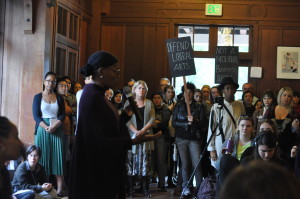
Over the summer, it was voted, as The Campanil understands, by the Board of Trustees, to lower the amount of money being taken out of Mills College’s endowment, from 6.5%, to 5%.
Currently, according to Economics Professor Roger Sparks, Mills is currently taking roughly 5.25% out of the endowment for this
fiscal year.
However, the decrease in spending of the endowment has led to budgetary cuts of about $3 million across the campus culminating in the proposals sent out by Mills President Alecia DeCoudreaux on Monday, Oct. 19. Among those proposals is a “teach-out” of both the American Studies and Book Art programs, as well as the elimination of the dance undergraduate major.
Other proposed changes include grouping programs such as the public policy, government and international relations into one field of study, with those programs becoming either concentrations or minors. The same is proposed with the current African Diaspora, Latin American, French and Francophone and Spanish and Spanish American studies, as well as literary and cultural studies and philosophy.
Also among the proposed cuts were additions and revisions to the College’s curriculum including data science, an Economics Masters program, and urban studies. Some of these proposed programs had been voted on or proposed by faculty members. However no other aspect of the outlined changes, including the cuts, had been known to the faculty prior to a meeting on Oct. 19, only hours before the memo was sent out to students.
On Oct. 21, Professor of Education Sabrina Zirkel and members of the Facility Executive Committee (FEC) sent out an email to students and faculty concerning the way in which the cuts of the american studies, dance major and book art programs were proposed to
the college.
Typically when curriculum changes are under consideration, the proposal is to be brought to the Educational Policy
Committee (EPC, a subcommittee of the FEC), approved by them, and then brought to and voted on by the full faculty. Zirkel’s email notes that at this time, there has been no concrete proposal brought to the EPC.
Currently, the only decisions that have been made are general education requirements and additions to the curriculum including an ethnic studies major and the addition of minors in creative writing and history of philosophy. The email also said the MFA in Translation was approved last month. This low residency program according to the Mills website, will be a five semester long program with two week long intensive courses. “Nearly any language” will be available.
The Core Curriculum, also known as gen-eds, has been reconfigured and will go into effect in the Fall of 2016.
One of the more notable changes in the gen-eds is the addition of Race, Gender and Power, which is in part due to the first requirement on the list of demands released by the Black Students Collective (at the time, the Black Women’s Collective). According to Interim Provost Sharon Washington, the new requirement has to do with power structures in society. Things that could potentially be covered would be white supremacy or male dominance over marginalized races
and genders.
According to Diane Ketelle, professor of education, many of the proposed additions to the college came from a renewed emphasis on multi or interdisciplinary courses and programs.
Sparks put forth the proposal for the master’s in economics. According to him, only one course will have to be added in order for the first set of classes to be offered. He also released a poll to about 40 students and 17 of them said they would be interested in pursuing a masters in economics at Mills.
There are other counter proposals and appeals being worked on by both professors and students. As of Oct. 30, none have been released. At an emergency faculty meeting held Monday Oct. 28, a letter to the Mills community was put together by attending faculty members. In addition, faculty began to put together their own counter proposals, which according to faculty sources include new low cost programs as well as cuts across the school and across departments, instead of the cuts affecting only a few areas.
The Blue and Gold paper is currently being drafted by students and is expected to be sent out on Nov. 11. The Blue and Gold paper contains demands from students and ideas about budget cuts across the campus that are not necessarily curriculum based. At least one of the suggestions from students called for a decrease in President DeCoudreaux’s pay. As reported by The Campanil, the President has a salary of $401,539 and an “additional compensation” of $100,717 from the organization and related organizations, according to the College’s 2012 990 form. According to a
report from Howard Bunsis, professor of accounting at Eastern Michigan University, who presented a financial analysis of Mills College in February 2015, as of 2014, full time faculty receive $118,626, associate professors receive $94,368 and assistant professors receive $65,605.
On average, the salaries of both the College president and professors are on par with national averages, albeit on the lower side. According to the Washington Post, the average is $126,98 for faculty, $50,032 for instructors and according to US News, between $480,000 and $500,000 for liberal arts
college presidents.
However, Sparks raises the question that if students and faculty are willing to work on and create plans where the proposed amount to be cut is spread out through campus, is Mills really in a tough
financial crisis?
He presented to the Board of Trustees on Oct. 6 that Mills should switch its endowment payout and management to be a passively managed fund, instead of an actively managed fund, which means that less money (around $4 million) in consultant and accounting costs would come out of Mills’ funds. Sparks’ math suggests that if Mills had switched to a passive endowment management scheme about five years ago, the value of the endowment would be about $100
million higher.
At the time of release, the Mills community has just over three weeks to come up with a proposal that will cut $3 million for when the budget is voted on by the Board of Trustees on Dec. 1.



